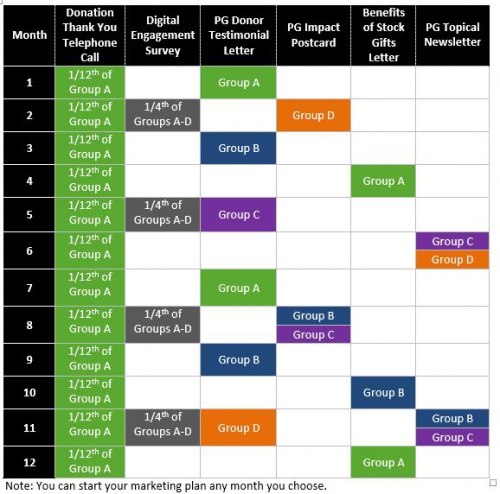Planned giving – sometimes considered the “Cinderella fundraising program” by some organizations – can look intimidating to the untrained. But with an anticipated $1-$2 trillion (with a ‘T”) in charitable gifts expected to be given by the Baby Boom generation over the coming several decades, marketing planned giving concepts is important to your bottom line.
Planned gifts can often account for 10 – 30% of an organization’s annual revenue, and the percentage can increase with a steady, proactive program. Today’s chief development officers understand that a strong planned giving effort is integral to a healthy well-rounded fundraising strategy.
Promoting this gift type to huge masses, however, isn’t always the best way to uncover or close planned gifts…. And the longer you wait to start a planned gift marketing program the longer you’ll wait for planned gift revenue to come in.
Your Target Analytics predictive modeling scores for planned gifts can be used to segment constituents into groups for varying treatment. Simply decide who will get what and when. A cadenced marketing plan is a smart plan. You speak to those more likely to make a planned gift more often than those that don’t. It’s like dating with the intent to find the perfect mate for a commitment relationship. You wouldn’t likely propose marriage to someone that didn’t appear to have interest in you. That’s not to say given time and extended dating there’s no chance at building a relationship – there is! So goes a cadenced marketing plan…. Start with those with the highest interest in you without ignoring potential mates on the fringes of your universe.
I’ve laid out a 12-month marketing plan for your consideration. I’ve created four groups of prospects based on likelihood score and current or distance giving patterns.
Using these segments, I’ve planned more contact with Group A, and less with Groups B, C and D. Here’s the basic format of my rationale.

The segments you choose might be different and the cadence could vary as well. For instance, you might choose to contact Group A four times a year, Group B three times, Group C two times and Group D only once.
I’ve chosen a more robust plan with multiple types of contacts throughout the year including phone calls, digital contact, personal letters and mass-marketed communications. I also know that personal conversations about planned gifts over ‘through the mail’ transactions is most organization’s preference – so personal contact is also included. Group A will receive the most attention and the largest share of our marketing budget. Group D, on the other hand, will receive the smallest share of the marketing budget while not being ignored or overlooked.
Here’s how my Planned Giving 12-Month Marketing Plan looks:

Your organization should consider which planned gifts to promote and accept – and your marketing plan will focus on those topics. But in this blog, I’m working to focus you not on content, but on contact.
The longer you wait to start promoting even simple planned gifts like bequests and non-probate transfer gifts, the more revenue you’re losing…..year after year. The strongest planned giving programs build over time, but there’s no time like the present to begin getting the word out that your organization likes, encourages and accepts planned gifts. The Boomer Trillion is coming. How prepared is your organization to start building a pipeline of gifts to capture your share?
Promoting this gift type to huge masses, however, isn’t always the best way to uncover or close planned gifts…. And the longer you wait to start a planned gift marketing program the longer you’ll wait for planned gift revenue to come in.
Your Target Analytics predictive modeling scores for planned gifts can be used to segment constituents into groups for varying treatment. Simply decide who will get what and when. A cadenced marketing plan is a smart plan. You speak to those more likely to make a planned gift more often than those that don’t. It’s like dating with the intent to find the perfect mate for a commitment relationship. You wouldn’t likely propose marriage to someone that didn’t appear to have interest in you. That’s not to say given time and extended dating there’s no chance at building a relationship – there is! So goes a cadenced marketing plan…. Start with those with the highest interest in you without ignoring potential mates on the fringes of your universe.
I’ve laid out a 12-month marketing plan for your consideration. I’ve created four groups of prospects based on likelihood score and current or distance giving patterns.
Group A = Last gift is within the last 24 months AND likelihood score is greater than 900
Group B = Last gift is within the last 24 months AND likelihood score is between 801-900
Group C = Last gift is within the last 24 months AND likelihood score is between 701-800
Group D = Last gift is before 24 months ago or total gifts = $0 AND likelihood score is between 701-1000
Using these segments, I’ve planned more contact with Group A, and less with Groups B, C and D. Here’s the basic format of my rationale.

The segments you choose might be different and the cadence could vary as well. For instance, you might choose to contact Group A four times a year, Group B three times, Group C two times and Group D only once.
I’ve chosen a more robust plan with multiple types of contacts throughout the year including phone calls, digital contact, personal letters and mass-marketed communications. I also know that personal conversations about planned gifts over ‘through the mail’ transactions is most organization’s preference – so personal contact is also included. Group A will receive the most attention and the largest share of our marketing budget. Group D, on the other hand, will receive the smallest share of the marketing budget while not being ignored or overlooked.
Here’s how my Planned Giving 12-Month Marketing Plan looks:

Your organization should consider which planned gifts to promote and accept – and your marketing plan will focus on those topics. But in this blog, I’m working to focus you not on content, but on contact.
The longer you wait to start promoting even simple planned gifts like bequests and non-probate transfer gifts, the more revenue you’re losing…..year after year. The strongest planned giving programs build over time, but there’s no time like the present to begin getting the word out that your organization likes, encourages and accepts planned gifts. The Boomer Trillion is coming. How prepared is your organization to start building a pipeline of gifts to capture your share?
News
ARCHIVED | Blackbaud Target Analytics® Tips and Tricks
12/12/2016 3:26pm EST


Leave a Comment
The tricky part is that we then need to be able to drill down and manage and personalize individual contacts within each segment. Here's where I think there is such a gap in present day CRM software. It takes a calendaring and messaging guru to coordinate the treatment by segment while also offering authentic, personalized engagement at the individual level.
Moreover, where is the database software that integrates Outlook's email/calendar with CRM donor engagement functions that makes such interactive engagement possible? Mostly missing in action. Contemporary CRM donor databases generally perform well in executing campaigns, moves, and segment communications. Yet my observation of out-the-door fundraisers is that their daily lives center around mobile pones and Outlook.. Not databases
What happens then when a fundraiser starts getting emails, phone calls, texts, and other messages from individuals from the various segments? More importantly, how does one truly engage in "learning relationships" with donors in the fashion that Peppers & Rogers speak about where each interaction is an opportunity to gather more donor insight, learn from that insight, and then interact based upon such knowledge.
"Katherine, you told me of your interest in X. I listened. I am now communicating with you based upon that knowledge."
Katherine, I imagine that you are in contact with fundraisers from around the country from organizations large and small. Are you seeing examples of more organizations successfully executing the marketing cadence that you note in your post? Are there any standout characteristics that depict successful organizations and their fundraisers who are executing interactive major and planned gift treatments in such a disciplined fashion?